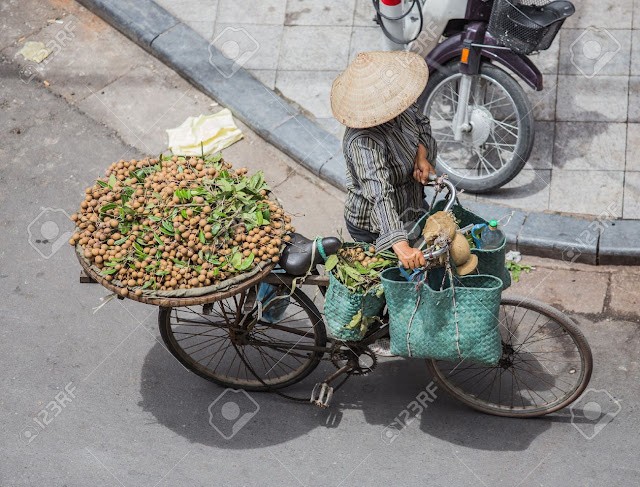We met Ms. Hung on Nguyen Van Cu street, squatting next to her yoke full of snacks and condiments. She sells a type of rice paper snack that is cut up in strips and mixed with lime, seasoning, nuts, and other delicious additions. We squatted down next to her to speak with her about her daily life. Moment of enlightenment #1: squatting for 12 hours a day is as uncomfortable as it looks. We probably adjusted ourselves 30 times during our conversation, all the while perplexed as to how she ‘sat’ like that all day! We were sure our legs would give out at some point! Moment of enlightenment #2: we learned that her yoke weighs 30 kilograms! We took a shot at carrying her yoke and failed miserably… We were dumbfounded that a 50 year old frail woman could carry all this weight on her shoulders and we couldn’t even get it off the ground! It was at about this point where we decided we should just stick to what we are good at – writing.
Me: Ms. Hung, tell us about your family.
Ms Hung: I’m from Binh Dinh province [Central Vietnam, and we figured as much by her accent!]. My husband has been very ill for a long time. I have two sons, both in university, and one daughter. My one son studies transportation and the other studies agricultural industries. They are very intelligent!
Street vendor.
Me: Amazing! How does your family afford the university education? Do your sons work?
Ms Hung: No, actually the government helps out and gives a grant for students. The rest of the money I earn for them.
Me: Do you miss your husband? :)
Ms Hung: *Blushes* Yes. But my daughter is there to take care of him so I know he’s okay.
Me: Does your daughter work?
Ms Hung: No she takes care of the house. We raise our own animals – ducks, pigs, cows, chickens. She also takes care of my husband.
Me: How often do you go back to see your family?
Ms Hung: Only 3 times a year.
Me: How long have you been in the city?
Ms Hung: 5 years now. It’s very difficult but we can make a lot more money in the city. There is no money where we live.
Me: So where do you live here?
Ms Hung: There is a house really near by. More than 50 people live in one house. We are all workers with similar jobs.
Me: 50 people!? How much does it cost to stay there?
Ms Hung: 500,000 VND per month.
Me: Wow. The owner must make a lot of money in rent! Do you like the people you live with?
Street vendor.
Ms Hung: Oh yes, very much. We are all friends!
Me: Lucky! How much money do you make in one month?
Ms Hung: Well, I earn around 30,000 VND of profit a day. I shop at the Cau Muoi market so my costs aren’t too much. I make enough to support my family and pay my rent here.
Me: When you get hungry, do you bring lunch from home or do you just make your self a rice paper snack?
Ms Hung: I usually bring my food from home. We have a small kitchen and we take turns cooking for everyone. If I don’t have food, I’ll snack on some quail eggs and peanuts! It’s my favourite snack! It is a special Buddhist holiday right now so I am eating vegetarian lunch today.
Me: That’s right! Did you go to the temple today?
Ms Hung: No, actually I do not get time to go. I have to work.
Ms. Hung then pulled out her lunch to show us (and to eat obviously, since we were encroaching on her lunch time). She ate a bowl of lentils and rice that day, and that’s what she was going to have for dinner as well. She said it was a really inexpensive meal. It is very commendable to see the kind of work ethic that she has, especially when her family is many miles away from her. She draws from the strength of her family to survive in the city, and looks forward to her visits back home.
Street vendor.
We have many more interviews as well as Vietnam travel tips coming up!










